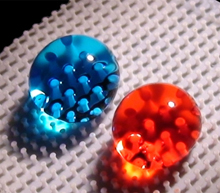Making Materials Untouchable
Materials under development at MIT could lead to coatings that repel both water and oil. A group of MIT researchers have created an improved set of design rules for making any surface impervious to any liquid, be it water or gasoline. Such materials could eventually have promise as fingerprint-repelling coatings, fuel filters, self-washing car paints, and stain-resistant clothing.

Last year, the MIT group, led by chemical engineer Robert Cohen and mechanical engineer Gareth McKinley, created the first superoleophobic, or oil-repellant, surfaces. They started with a polymer developed by the Air Force that contains large numbers of oil-repelling fluorine groups. The MIT researchers made the material even more oil resistant by using lithography to pattern it with overhanging microstructures. These tiny structures create air pockets that help suspend liquids and prevent them from penetrating to the surface. The MIT researchers found that the surfaces are both superoleophobic and also superhydrophobic, or water repelling. Because they repel everything, they’re called omniphobic.
Although these were the least wettable materials ever developed, it wasn’t clear last year how much pressure the materials could withstand before the liquid would sag into the air pocket, causing the surface to fail. In their new work, the MIT researchers used mathematical models of surface properties to predict how changes in the surface geometry would improve resistance to pressure, allowing them to make surfaces that withstand greater pressure. Based on the properties of a given surface and a given liquid, the models can predict the contact angle between them. A high contact angle means that the liquid will bead up and easily roll off. The MIT researchers use their equations to predict how best to modify a surface in order to increase the contact angle.
These design rules don’t just apply to one particular material. The MIT researchers have shown that a combination of structure and chemistry can turn any surface omniphobic, says Weihua Ming, a professor in the nanostructured-polymers research group at the University of New Hampshire. The MIT surfaces, says Di Gao, a professor of chemical and petroleum engineering at the University of Pittsburgh, are truly superomniphobic: they repel all liquids, causing them to bead up and roll off.
However, you won’t find these coatings on your next iPod. Major practical issues remain. “The issue with a lot of these surfaces is that they may not be mechanically robust,” says Chuck Extrand, principal scientist at Entegris, which makes fluid-handling equipment for the semiconductor industry. But Extrand says that in principle, it’s possible to make these surfaces more durable. “I’m still hopeful we’ll find something that’s mechanically robust,” he says.
Right now, to make flat omniphobic surfaces, the researchers need to make them on a silicon wafer using lithography. However, the team is working on designs for spraying or dip-coating flat surfaces.
Keep Reading
Most Popular
Large language models can do jaw-dropping things. But nobody knows exactly why.
And that's a problem. Figuring it out is one of the biggest scientific puzzles of our time and a crucial step towards controlling more powerful future models.
How scientists traced a mysterious covid case back to six toilets
When wastewater surveillance turns into a hunt for a single infected individual, the ethics get tricky.
The problem with plug-in hybrids? Their drivers.
Plug-in hybrids are often sold as a transition to EVs, but new data from Europe shows we’re still underestimating the emissions they produce.
Google DeepMind’s new generative model makes Super Mario–like games from scratch
Genie learns how to control games by watching hours and hours of video. It could help train next-gen robots too.
Stay connected
Get the latest updates from
MIT Technology Review
Discover special offers, top stories, upcoming events, and more.